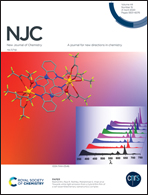Sensitive and selective colorimetric probe for fluoride detection based on the interaction between 3-aminophenylboronic acid and dithiobis(succinimidylpropionate) modified gold nanoparticles†
Abstract
In this study, a sensitive and selective colorimetric probe for fluoride detection was established. The detection strategy is based on the interaction between dithiobis(succinimidylpropionate) modified gold nanoparticles (DSP@AuNP) and 3-aminophenylboronic acid (APBA), which was used as the recognition molecule for fluoride. AuNPs were modified with DSP, a notable amine coupling ligand, so that they can bind with the amino group of APBA to furnish a colorimetric probe denoted as APBA–DSP@AuNP. The boronic acid moiety of the probe is appropriately positioned to bind with fluoride in a slightly acidic environment provided by phosphate buffer (pH = 5.2) through the Lewis acid–base interaction, resulting in the probe's aggregation. The color of APBA–DSP@AuNP undergoes different color transitions from ruby red to purple and blue-gray within 15 minutes, depending on the concentration of fluoride. The absorbance ratio (A650/A520) was used as the analytical signal, which was linear with fluoride concentration over two ranges of 75–1000 μM and 1000–3000 μM. The limit of detection was estimated as 56.5 μM, which was much lower than the maximum acceptable limit of fluoride (210 μM) in drinking water given by the US EPA. The practical applicability of APBA–DSP@AuNP was demonstrated by applying it to fluoride detection in tap water, with acceptable accuracy (97 to 102%).



 Please wait while we load your content...
Please wait while we load your content...